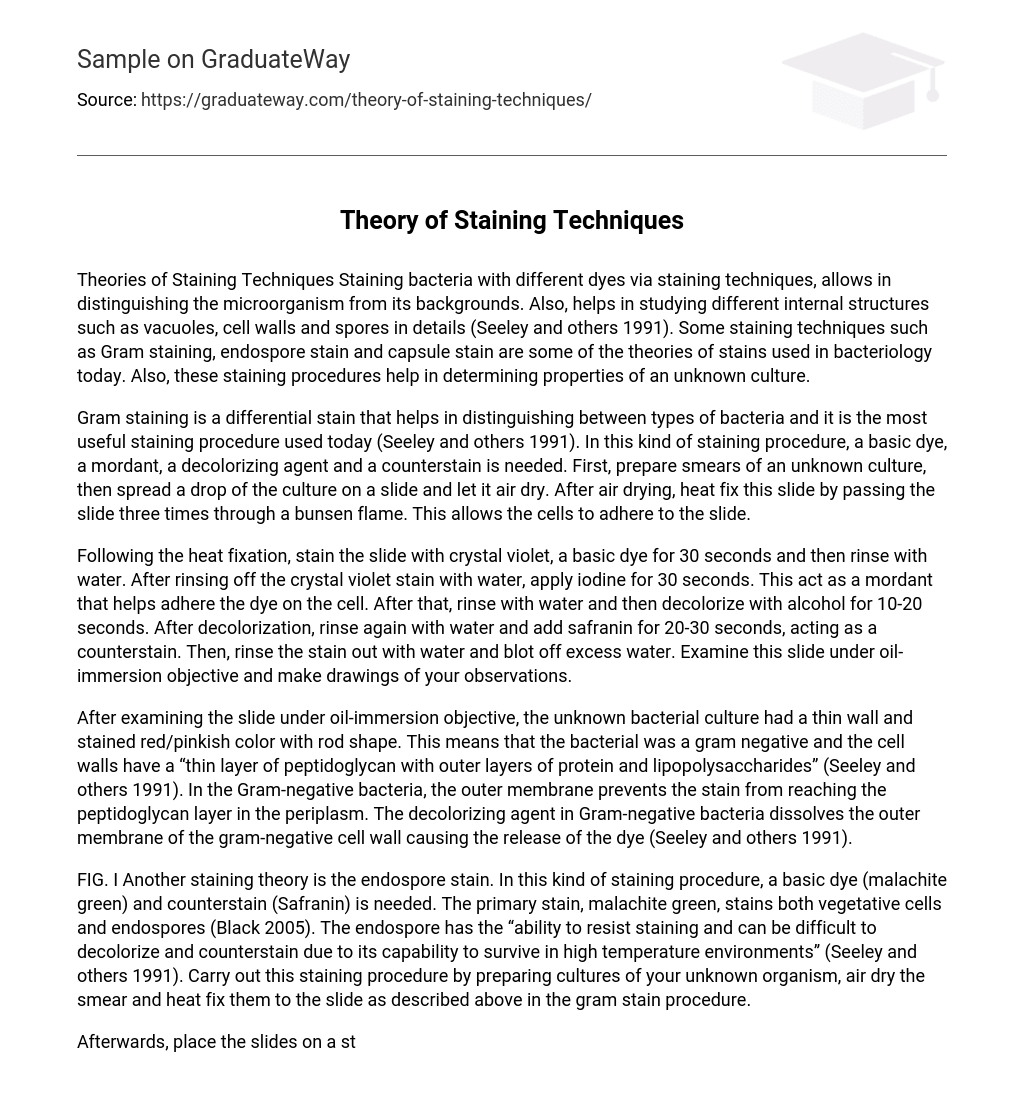Theories of Staining Techniques Staining bacteria with different dyes via staining techniques, allows in distinguishing the microorganism from its backgrounds. Also, helps in studying different internal structures such as vacuoles, cell walls and spores in details (Seeley and others 1991). Some staining techniques such as Gram staining, endospore stain and capsule stain are some of the theories of stains used in bacteriology today. Also, these staining procedures help in determining properties of an unknown culture.
Gram staining is a differential stain that helps in distinguishing between types of bacteria and it is the most useful staining procedure used today (Seeley and others 1991). In this kind of staining procedure, a basic dye, a mordant, a decolorizing agent and a counterstain is needed. First, prepare smears of an unknown culture, then spread a drop of the culture on a slide and let it air dry. After air drying, heat fix this slide by passing the slide three times through a bunsen flame. This allows the cells to adhere to the slide.
Following the heat fixation, stain the slide with crystal violet, a basic dye for 30 seconds and then rinse with water. After rinsing off the crystal violet stain with water, apply iodine for 30 seconds. This act as a mordant that helps adhere the dye on the cell. After that, rinse with water and then decolorize with alcohol for 10-20 seconds. After decolorization, rinse again with water and add safranin for 20-30 seconds, acting as a counterstain. Then, rinse the stain out with water and blot off excess water. Examine this slide under oil-immersion objective and make drawings of your observations.
After examining the slide under oil-immersion objective, the unknown bacterial culture had a thin wall and stained red/pinkish color with rod shape. This means that the bacterial was a gram negative and the cell walls have a “thin layer of peptidoglycan with outer layers of protein and lipopolysaccharides” (Seeley and others 1991). In the Gram-negative bacteria, the outer membrane prevents the stain from reaching the peptidoglycan layer in the periplasm. The decolorizing agent in Gram-negative bacteria dissolves the outer membrane of the gram-negative cell wall causing the release of the dye (Seeley and others 1991).
FIG. I Another staining theory is the endospore stain. In this kind of staining procedure, a basic dye (malachite green) and counterstain (Safranin) is needed. The primary stain, malachite green, stains both vegetative cells and endospores (Black 2005). The endospore has the “ability to resist staining and can be difficult to decolorize and counterstain due to its capability to survive in high temperature environments” (Seeley and others 1991). Carry out this staining procedure by preparing cultures of your unknown organism, air dry the smear and heat fix them to the slide as described above in the gram stain procedure.
Afterwards, place the slides on a staining rack over boiling water. Be sure the water is boiling and not just steaming, as this will affect the results. Then, cover the smears with a small piece of paper and apply malachite green to the piece of paper. Fully saturate the small piece of paper with this solution and continue to heat for 5 minutes. Next, rinse the slide with water and counterstain with safranin for 30 seconds. Allow the whole 30 seconds to pass and then wash with water and blot dry. Afterwards, view the slide under the oil-immersion objective and record results of any observations.
Following the above procedure, it was observed that no endospore was found in our unknown culture. The endospores appeared ruptured and damaged. This could be due to an error in the procedural steps above as to the allotted time of staining is very crucial when performing this procedure. However, a normal observation of an endospore staining would have “green stained endospores and the rest of the cells without endospore cells” (Seeley and others 1991). In addition, if a simple stain is used, the spores will appear clear because the walls of endospores resist stain penetration (Black 2005). FIG II
A different kind of stain is the capsule stain. In this staining procedure, the capsules in a cell are not stained intensely because they vary in thickness and can repel stains (Seeley and others 1991). Congo red is the primary stain in this procedure, which stains both bacterial cell and the surrounding capsule (Seeley and others 1991). To start off, place several loopfuls of unknown culture in Congo red solution on a glass slide. Then, allow the slide to air dry. However, do not heat-fix as noted in the above two staining procedures. Next, flood the smear with Maneval’s stain for at least 1 minute, then rinse with water and blot dry.
Following that, observe the slide under the oil-immersion objective and record any findings of the capsules unstained ad blue or black backgrounds. After observation of the slide, the capsule stain of the unknown culture appeared unstained with a blackish background and the cells were reddish brown and they were large and arranged in pairs, which indicates that there is presence of some bacterial species (Black 2005). Thus, a typical slide will show a dark pink background of acidic dye and crystal violet counterstain (Black, 2005). FIG III
In conclusion, all these stains help in determining several characteristics of an unknown culture such as shapes, sizes and arrangement of the cells. Also, helps us distinguish a gram negative organism from gram positive organisms. In addition, help in visualizing the internal structures of an organism that will not accept stains, such as capsules. As Black (2005) point out, although it is possible to obtain valuable information about microorganisms from these techniques, we cannot identify most microbes via these techniques. This suggests that other biochemical compositions have to be determined in order to identify these microbes.





